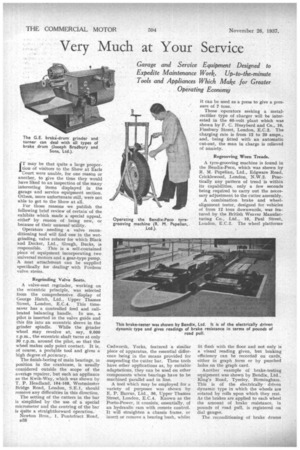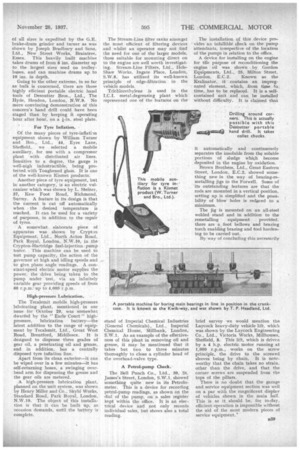Very Much at Your Service
Page 22

Page 23

If you've noticed an error in this article please click here to report it so we can fix it.
Garage and Service Equipment Designed to Expedite Maintenance Work. Up-to-the-minute Tools and Appliances Which Make for Greater Operating Economy
IT may be that quite a large proportion of visitors to the Show at Earls Court were unable, for one reason or another, to give the time they would have liked to an inspection of the many interesting items displayed in the garage and service equipment section. Others, more unfortunate still, were not able to get to the Show at all.
For those reasons we publish the following brief review of certainof the exhibits which made a special appeal, either by reason of being new, or because of their unusual utility.
Operators needing a valve reconditioning tool will find one in the wetgrinding, valve refacer for which Black and Decker, Ltd., Slough, Bucks, is responsible. This is a self-contained piece of equipment incorporating two universal motors and a gear-type pump. A neat attachment can be supplied specifically for dealing. with Fordson valve stems.
• Regrinding Valve Seats.
A valve-seat regrinder, working on the eccentric principle, was selected from the comprehensive display of George Hatch, Ltd., Upper Thames Street, London, E.C.4. This timesaver has a controlled feed and calibrated balancing handle. In use, a pilot is inserted in the valve guide and this fits into an eccentric sleeve in the grinder spindle. While the grinder wheel may revolve at, say, 9,000 r.p.m., the eccentric shaft turns at only 30 r.p.m. around the pilot, so that the wheel makes only point contact. It is, of course, a portable tool and gives a high degree of ,accuracy.
The finish-boring of main bearings, in position in the crankcase, is usually considered outside the scope of the average repairer, but such an appliance as the Kwik-Way, which was shown by T. P. Headland, 164-168, Westminster Bridge Road, London, SE.!, should remove any difficulties in this direction.
The setting of the cutters in the bar is simplified by the use of a special micrometer and the centring of the bar is quite a straightforward operation.
Newton Bros., I, Pontefract Road, e38 Cudworth, Yorks, featured a similar piece of apparatus, the essential difference being in the means provided for • suspending the cutter bar. These tools have other applications as, by suitable adaptations, they can be used on other components where bearings have to be machined parallel and in line.
A tool which may be employed for a variety of purposes was shown by E. P. Barrus, Ltd., 36, Upper Thames Street, London, E.C.4. Known as the Porto-Power, it consists, essentially, of an hydraulic ram with remote control. It will straighten a chassis frame, or insert or remove a bearing bush, whilst it can be used as a press to give a pressure of 7 tons.
Those operators seeking a metalrectifier type of charger will be interested in the 60-volt plant which was shown by F. C. Heayberd and Co., 10, Finsbury Street, London, E.C.2. The charging rate is from 12 to 20 amps., and, being fitted with an automatic cut-out, the man in charge is relieved of anxiety.
Regrooving Worn Treads.
A tyre-grooving machine is found in the Bendix-Peco, which was shown by R. M. Papeliai2, Ltd., Edgware Road, Cricklewood, London, N.W.2. Practically any pattern of tread is within its capabilities, only a few seconds being required to carry out the necessary adjustment to the cutter assembly.
A combination brake and wheelalignment tester, designed for vehicles of from 12 tons downwards, was featured by the British Weaver Manufacturing Co., Ltd., 10, Paul Street, London, E.C.2. The wheel platforms fit flush with the floor and not only is a visual reading given, but braking efficiency can be recorded on cards, either in graph form or by punched holes on the graph card.
Another example of brake-testing equipment was shown by Bendix, Ltd., King's Road, Tyseley, Birmingham. This is of the electrically driven dynamic type in which the wheels are rotated by rolls upon which they rest. As the brakes are applied to each wheel the amount of brake resistance, in pounds of road pull, is registered on dial gauges.
The reconditioning of brake drums of all sizes is expedited by the G.E. brake-drum grinder and turner as was shown by Joseph Bradbury and Sons, Ltd., New Street Works, Braintree, Essex. This heavily built machine takes drums of from 8 ins, diameter up to the largest sizes used on trolley
buses, and can machine drums up to ICI ins. in depth.
Going to the other extreme, in so far as bulk is concerned, there are those highly efficient portable electric hand tools of Desoutter Bros., Ltd., The Hyde, Hendon, London, N.W.9. No more convincing demonstration of this concern's hand drill could have been staged than by keeping i`t operating hour after hour, on a I-in. steel plate.
For Tyre Inflation. •
Of the many pieces of tyre-inflathn equipment shown by William Turner and Bro., Ltd., 44, Eyre Lane, Sheffield, we selected a mobile auxiliary, for use with a compressor plant with distributed air lines. Sensitive to a degree, the gauge is well-nigh indestructible, being protected.with Toughened glass. It is one of the well-known Kismet products.
Another piece of tyre equipment, but in another category, is an electric vulcanizer which was shown by L. Steiner, 37, Kew Foot Road, Richmond, Surrey. A feature in its design is that the current is cut off automatically when the desired temperature is reached. It can be used for a variety of purposes, in addition to the repair of tyres.
A somewhat elaborate piece of apparatus was shown by Crypton Equipment, Ltd., North Acton Road, Park Royal, London, N.W.10, in the Crypton-Hartridge fuel-injection, pump tester. This machine can be used to test pump capacit5.,,, the action of the governor at high and idling speeds and to give phase angle readings. A constant-speed electric motor supplies the power, the drive being taken to the pump under test, via an infinitely variable gear providing ppeeds of from 60 r.p.m: up to 4,000 r.p.m.
High-pressure Lubrication.
The Tecalemit mobile high-pressure lubricating 'plant, mentioned in our issue for October 29, was soinewhat dwarfed by the " Earls' Court " highpressure, lubrication battery—the latest addition to the range of equipment by Tecalemit, Ltd., Great West Road, Brentforcl, Middlesex. It is designed to dispense three grades of gear oil, a penetrating oil and grease, and in addition, has a centrally disposed tyre inflation line.
Apart from its clean exterior—it can be wiped over in a few minutes—it has self-returning hoses, a swinging overhead arm for dispensing the grease and the gear oils are metered.
A high-pressure lubrication plant, planned on the unit system, was shown by Henry Miller and Co., Skyhi Works, Standard Road, Park Royal, London, N.W.I0. The object of this installation is that it can be built up, as occasion demands, until the battery is complete. The Stream-Line filter ranks amongst the most efficient of filtering devices and whilst an operator may not find the need for one of the larger models, those suitable for mounting direct on to the engine are well worth investigating. Stream-Line Filters, Ltd., HeleShaw Works, •Ingate Place, London, S.W.8, has utilized its well-known principle of edge-filtration in the vehicle models. • Trichlorethylene is used in the I.C.I. metal-degreasing plant which represented one of the features on the stand of Imperial Chemical Industries (General Chemicals), Ltd., Imperial Chemical House, Millbank, London, S.W.I. As an example of the effectiveness of this plant in removing oil and grease, it may be mentioned that it takes but two to three minutes thoroughly to clean 'a cylinder head of the overhead-valve type.
A Petrol-pump check.'
The Bell Punch Co., Ltd., 39, St. James's Street, London, S,W.I, showed something quite new in its Petrolometer. This is a device for recording petrol-pump readings, as shown on the dial of the pump, on a sales register kept within the office. It is an electrical device and not only records individual sales, but shows also a total reading.
The installation of this device provides an infallible check on the pump attendants, irrespective of the location of the pumps in relation to the office.
A device for installing on the engine for tlie purpose of reconditioning the engine oil was shown by Gordon Equipments, Ltd., 25, Milton Street, London, E.C.2. Known as the Kralinator, it contains an impregnated 'element, which, from time to time, has to be replaced. It is a selfcontained unit and can be installed without difficulty. It is claimed that it automatically and continuously separates the insoluble from the soluble portions of sludge which become deposited in the engine by oxidation.
Brown Brothers, Ltd., Great Eastern Street, London, E.C.2, showed something new in the way of bearing-remetalling jigs in the ForwelL Some of its outstanding features are that the rods are mounted in a vertical position, setting up is simplified and the possibility of blow holes is reduced to a minimum.
The jig is mounted on an all-steel welded stand and in addition to the remetalling equipment provided. there are a, foot bellows and brazing torch enabling brazing and tool hardening to be carried out.
By way of concluding this necessarily
brief survey we would mention the Laycock heavy-duty vehicle lift, which was shown by the Layoock Engineering Co., Ltd., Victoria Works, Millhouses, Sheffield, 8. This lift, which is driven by a 4 h.p. electric motor running at 1,000 r.p.m., works on the screw principle, the drive to the screwed sleeves being by chain. It is noteworthy that the chain takes no strain. other than the drive, and that the corner screws are suspended from the tops of the pillars.
There is no doubt that the garage and service equipment section was well on a par with the magnificent display of vehicles shown in the main ball. This is as it should be, for to-day, efficient operation is impossible without the aid of the most modern pieces of
service equipment.' B39






























